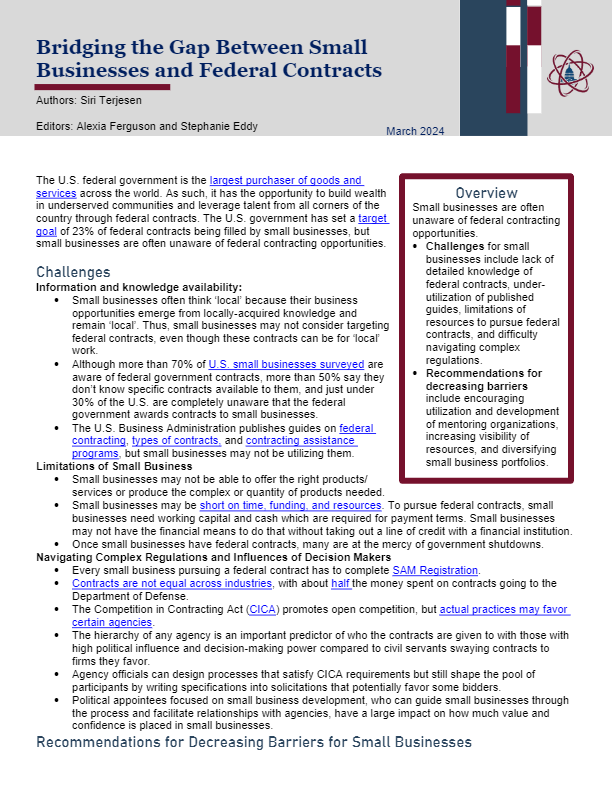
The U.S. federal government is the largest purchaser of goods and services across the world. As such, it has the opportunity to build wealth in underserved communities and leverage talent from all corners of the country through federal contracts. The U.S. government has set a target goal of 23% of federal contracts being filled by small businesses, but small businesses are often unaware of federal contracting opportunities.
Challenges
Information and knowledge availability:
- Small businesses often think ‘local’ because their business opportunities emerge from locally-acquired knowledge and remain ‘local’. Thus, small businesses may not consider targeting federal contracts, even though these contracts can be for ‘local’ work.
- Although more than 70% of U.S. small businesses surveyed are aware of federal government contracts, more than 50% say they don’t know specific contracts available to them, and just under 30% of the U.S. are completely unaware that the federal government awards contracts to small businesses.
- The U.S. Business Administration publishes guides on federal contracting, types of contracts, and contracting assistance programs, but small businesses may not be utilizing them.
Limitations of Small Business
- Small businesses may not be able to offer the right products/ services or produce the complex or quantity of products needed.
- Small businesses may be short on time, funding, and resources. To pursue federal contracts, small businesses need working capital and cash which are required for payment terms. Small businesses may not have the financial means to do that without taking out a line of credit with a financial institution.
- Once small businesses have federal contracts, many are at the mercy of government shutdowns.
Navigating Complex Regulations and Influences of Decision Makers
- Every small business pursuing a federal contract has to complete SAM Registration.
- Contracts are not equal across industries, with about half the money spent on contracts going to the Department of Defense.
- The Competition in Contracting Act (CICA) promotes open competition, but actual practices may favor certain agencies.
- The hierarchy of any agency is an important predictor of who the contracts are given to with those with high political influence and decision-making power compared to civil servants swaying contracts to firms they favor.
- Agency officials can design processes that satisfy CICA requirements but still shape the pool of participants by writing specifications into solicitations that potentially favor some bidders.
- Political appointees focused on small business development, who can guide small businesses through the process and facilitate relationships with agencies, have a large impact on how much value and confidence is placed in small businesses.
Recommendations for Decreasing Barriers for Small Businesses
- Encourage utilization of mentoring organizations to bridge the gap between information about federal contracts and small businesses. The Venture Mentoring Team is one example of how this could work. Mentors can increase small business owners’ success in SAM registration, improve contacts across industries, and demystify complex regulations and political influences.
- Increase availability of Small Business Development Centers (SBDC) across the country (funded through the Small Business Administration) which have consultants, mentors, and others who can advise on federal contracts and other hurdles, such as registering for SAM. One example of publicly available information is the SBDCNet clearinghouse of government contracting resources.
- Increase visibility of small business resources within each targeted agency. For example, Health and Human Services has the HHS Office of Small and Disadvantaged Business Utilization.
- Diversify portfolios of small businesses, so they have contracts spread across different sectors and across states. Having both federal and non-federal contracts lowers the ‘risk’ associated with federal contracts during government shutdowns. One example is the small business The Right Stuff which produces an electrolyte drink additive that sells to the federal government, but also directly to consumers.
- Increase awareness of contingency plans for contractors during government shutdowns.
- Expand opportunities for political appointees to focus on small business development.
The Research-to-Policy Collaboration (RPC) works to bring together research professionals and public officials to support evidence-based policy. Please visit their website to learn more.
Key Information
RPC Website
Research-to-Policy Collaboration
Publication DateMarch 28, 2024
Topic Area(s)Economy and Entrepreneurship
Resource TypeWritten Briefs
Share This Page
The U.S. federal government is the largest purchaser of goods and services across the world. As such, it has the opportunity to build wealth in underserved communities and leverage talent from all corners of the country through federal contracts. The U.S. government has set a target goal of 23% of federal contracts being filled by small businesses, but small businesses are often unaware of federal contracting opportunities.
Challenges
Information and knowledge availability:
- Small businesses often think ‘local’ because their business opportunities emerge from locally-acquired knowledge and remain ‘local’. Thus, small businesses may not consider targeting federal contracts, even though these contracts can be for ‘local’ work.
- Although more than 70% of U.S. small businesses surveyed are aware of federal government contracts, more than 50% say they don’t know specific contracts available to them, and just under 30% of the U.S. are completely unaware that the federal government awards contracts to small businesses.
- The U.S. Business Administration publishes guides on federal contracting, types of contracts, and contracting assistance programs, but small businesses may not be utilizing them.
Limitations of Small Business
- Small businesses may not be able to offer the right products/ services or produce the complex or quantity of products needed.
- Small businesses may be short on time, funding, and resources. To pursue federal contracts, small businesses need working capital and cash which are required for payment terms. Small businesses may not have the financial means to do that without taking out a line of credit with a financial institution.
- Once small businesses have federal contracts, many are at the mercy of government shutdowns.
Navigating Complex Regulations and Influences of Decision Makers
- Every small business pursuing a federal contract has to complete SAM Registration.
- Contracts are not equal across industries, with about half the money spent on contracts going to the Department of Defense.
- The Competition in Contracting Act (CICA) promotes open competition, but actual practices may favor certain agencies.
- The hierarchy of any agency is an important predictor of who the contracts are given to with those with high political influence and decision-making power compared to civil servants swaying contracts to firms they favor.
- Agency officials can design processes that satisfy CICA requirements but still shape the pool of participants by writing specifications into solicitations that potentially favor some bidders.
- Political appointees focused on small business development, who can guide small businesses through the process and facilitate relationships with agencies, have a large impact on how much value and confidence is placed in small businesses.
Recommendations for Decreasing Barriers for Small Businesses
- Encourage utilization of mentoring organizations to bridge the gap between information about federal contracts and small businesses. The Venture Mentoring Team is one example of how this could work. Mentors can increase small business owners’ success in SAM registration, improve contacts across industries, and demystify complex regulations and political influences.
- Increase availability of Small Business Development Centers (SBDC) across the country (funded through the Small Business Administration) which have consultants, mentors, and others who can advise on federal contracts and other hurdles, such as registering for SAM. One example of publicly available information is the SBDCNet clearinghouse of government contracting resources.
- Increase visibility of small business resources within each targeted agency. For example, Health and Human Services has the HHS Office of Small and Disadvantaged Business Utilization.
- Diversify portfolios of small businesses, so they have contracts spread across different sectors and across states. Having both federal and non-federal contracts lowers the ‘risk’ associated with federal contracts during government shutdowns. One example is the small business The Right Stuff which produces an electrolyte drink additive that sells to the federal government, but also directly to consumers.
- Increase awareness of contingency plans for contractors during government shutdowns.
- Expand opportunities for political appointees to focus on small business development.
The Research-to-Policy Collaboration (RPC) works to bring together research professionals and public officials to support evidence-based policy. Please visit their website to learn more.

Key Information
RPC Website
Research-to-Policy Collaboration
Publication DateMarch 28, 2024
Topic Area(s)Economy and Entrepreneurship
Resource TypeWritten Briefs
Share This Page
LET’S STAY IN TOUCH
Join the Evidence-to-Impact Mailing List
Keep up to date with the latest resources, events, and news from the EIC.




